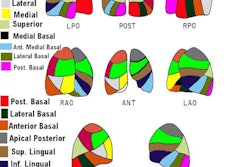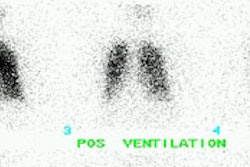Emphysema:
Clinical Findings
Emphysema is characterized by parenchymal destruction distal to the terminal bronchioles. Four subtypes of emphysema have been described according to their locations in the secondary pulmonary lobule: Panlobular, centrilobular, distal lobular (paraseptal), and paracicatrical (associated with scar and fibrosis) [AJR, April 1994, 791-98].
Centrilobular
Centrilobular emphysema is the most common form and is strongly associated with cigarette smoking. It tends to predominate in the upper portions of the individual lobes (apices in the upper lobes, superior segments of the lower lobes). There is central destruction of the secondary lobule alveoli around the proximal respiratory bronchiole are destroyed, while more distal alveoli are spared. The emphysematous spaces can coalesce to form bulla (sharply demarcated areas of emphysema larger than 1 cm in diameter). On HRCT it characteristically appears as areas of radiolucency surrounded by or interspersed with areas of more normal appearing lung.
Panlobular
In panlobular emphysema, which predominates in the lower lungs, there is destruction of the entire secondary lobule back to the level of the terminal bronchiole. Panlobular emphysema can be seen in alpha-1-antitrypsin deficiency and Swyer-James syndrome. On HRCT it appears as extensive areas of uniform low attenuation associated with a reduction in size of the pulmonary vessels.
Paraseptal (Distal lobular)
Paraseptal emphysema involves the periphery of the pulmonary lobule, especially adjacent to connective tissue septa. It is associated with spontaneous pneumothoraces, but not with air-flow obstruction. On HRCT it appears as multiple lucencies at the lung periphery delimited by normal interlobular septa.
Scintigraphic Findings
In patients with emphysema the Xenon-133 study will show multiple ventilation defects on the single breath view, which demonstrate abnormal Xenon retention on the washout study. The late equilibrium images are typically normal as the gas slowly distributes via collateral airways into the abnormal regions. On aerosol ventilation images, due to turbulent air flow, these patients typically demonstrate extensive central deposition of the tracer in the large airways. Ventilation images of an asthmatic patient will have an appearance which is identical to emphysema, and the two cannot be distinguished by ventilation imaging.
In patients with early or mild COPD, the perfusion scan may be normal or near normal. As a progresses of lung parenchymal destruction, it characteristically produces matched non-segmental ventilation-perfusion defects. Perfusion defects may also result from bullae themselves or by their compression of adjacent lung tissue. Large apical bullae may render very reduced or absent perfusion in the upper lung zones. Among patients with extensive obstructive airway disease, when the perfusion abnormalities exactly match the ventilation pattern on the single breath image, the incidence of PE has been shown to be low (4%), regardless of the pattern identified on washout images. A mismatch pattern with the single breath view, even if partial, was associated with a much higher incidence of PE (50%) [1].
Unfortunately, the presence of obstructive lung disease does not ensure that a matching perfusion defect does not result from an embolism. An embolus is occasionally bound to lodge in a region of emphysematous disease, although this is not common as emboli tend to occur in well perfused, rather than poorly perfused regions. At some point, however, abnormalities secondary to underlying obstructive lung disease can hinder interpretation of the V/Q scan. Previously the cutoff point was defined as a condition in which ventilation abnormalities occupy more than 50% of one lung or 75% of one lung zone. The modified PIOPED criteria classify extensive matched ventilation-perfusion abnormalities as low probability.
REFERENCES:
(1) J Nucl Med 1995; Elgazzar AH, et al. Perfusion and ventilation scans in patients with extensive obstructive airway disease: Utility of single-breath (washin) xenon-133. 36: 64-67

